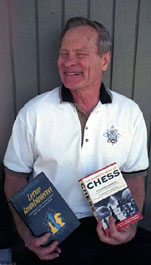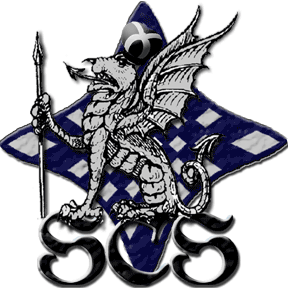

BOOKS FOR PARENTS TO HELP THEIR CHILD:
Dan
Heisman, A Parent's Guide to Chess, Milford, CT: Russell
Enterprises, 2002
Dan Heisman, Everyone's 2nd Chessbook. Davenport,
IA:Thinkers' Press, 2000
Beginning Chess
Books:
Bobby Fischer, Bobby Fischer Teaches Chess (Dr.
Kirshner's favorite)
Robert Snyder, Chess For
Juniors
Murray Chandler, How To Beat Your Dad At
Chess
Fred Reinfeld, How To Force Checkmate
Bruce
Pandolfini, Let's Play Chess
Bruce Pandolfini, Beginning
Chess
A.J. Gillam, Simple Chess Tactics
Laszlo Polgar,
Chess:5334 Problems
A.J. Gillam, Simple Checkmates
A.J.
Gillam, Improve Your Chess
A.J. Gillam, Your Move
Lev
Alburt, Comprehensive Chess Course
The Simon & Schuster Pocket
Book of Chess
Intermediate Chess Books:
Bruce
Pandolfini, Chess Openings: Traps and Zaps #1
Bruce
Pandolfini, Chess Openings: Traps and Zaps #2
Irving Chernev,
Practical Chess Endings
Jeremy Silman, Essential Chess Endings
Explained
George Koltanowski, Checkmate!
Bruce
Pandolfini, Chessercizes!
Bruce Pandolfini, More
Chessercizes!
Seirawan, Tactics
Purdy, The Search for
Chess Perfection
Max Euwe, Chess Master vs. Chess
Amateur
Evans, New Ideas in Chess
More
Advanced Books:
Irving Chernev, Invitation to
Chess
Fred Reinfeld, 1001 Brilliant Ways to
Checkmate
Fred Reinfeld, 1001 Winning Sacrifices and
Combinations
Reuben Fine, Ideas Behind the Chess
Openings
Reuben Fine, The Middle Game in Chess
Richard
Reti, Masters of The Chess Board
Bruce Pandolfini, Weapons of
Chess
Irving Chernev, Winning Chess
Irving Chernev,
The Most Instructive Games of Chess Ever Played.
Bill Wall, 700
Opening Traps
Bruce Pandolfini, Power Mates
Josh
Waitzkin, Attacking Chess
Jose Raul Capablanca, A Primer of
Chess (Richard Shorman recommends this book especially for
girls)
Renaud and Kahn, Art of Checkmate
Lev
Alburt, Chess Training Pocket Book
Lev Alburt, Just the
Facts
Alekhine, My Best Games of Chess
Nunn's Chess
Openings
Inspirational:
Xie Jun, Chess
Champion from China
Eric Schiller, Whiz Kids Teach
Chess
Searching for Bobby Fischer (the
video)
CD-Roms:
Commercial
Bobby Fischer
Teaches Chess
Maurice Ashley Teaches Chess
Special
Order
For Windows
Chess Mentor, (about$80) http://www.chess.com
ChessBase University,
(about $70) 1-800-524-3527
Tasc Chess, ($59.95) order W487 from US
Chess, 1-800-388-5464
For Mac
Think Like a King Chess
Workouts Series, W211,W212, W213 W214 from US Chess, 1-800-388-5464($14.95
each)
Your First Lessons in Chess,($17.95) order W210 from US Chess,
1-800-388-5464
ANNOTATED BIBLIOGRAPHY FROM
HENRY VINERTS, SCS SENIOR INSTRUCTOR (UPDATES-SUMMER 2004):
1. "Starting Chess" by Harriet Castor, 1995, $4.95. Good for
young
children. Parents can help to read and learn chess too.
2.
"Learn Chess - a Complete Course" by Alexander & Beach,
1994 (first
published in 1963), $14.95. An example of books that
have stood the
test of time (over 40 years, now). Two volumes in
one book, 94 and 174
pages, respectively, over 450 exercises with
answers. A lot on all
aspects of chess for the right price. For
fifth-graders and up,
depending on reading skills.
3. "1001 Brilliant Ways to Checkmate" by
Fred Reinfeld, reprinted
from 1955 and later editions, $10.00. Standard
diagrams for many
hours of practice. Explains the descriptive notation
which is used
for answers. Another example of an old book that should
not be
obscured by pricy new ones. Look also for other Reinfeld
books.
4. "A Primer of Chess" by Jose R. Capablanca, 2002 (first
publ.
in 1935), $14.00. A classic by former world champion.
5.
"Pandolfini's Endgame Course" by Bruce Pandolfini, 1988,
$13.00.
Although the editor has missed a number of "typos", the price
is
right for 239 endgame lessons with a glossary. If you have
no
endgame books at all, this is the first one to buy. Pandolfini
has
written many good instructional books.
6. "The Art of the
Checkmate" by Renaud & Kahn, 1953, $9.95.
>From 1952 original in
French. Another classic oldie. Descr. not'n.
7. "Learn Chess" by John
Nunn, 2000, $9.95, also in Spanish as
"Aprende Ajedrez", 2002. A good
overall text book fo older stud-
ents. Dr Nunn, a British GM, has
written many good books.
8. "Chess Openings the Easy Way" by Nick de
Firmian, 2003,
$15.95. Buy this book for your essential introduction to
openings,
but don't rush out to buy the big MCO, because opening
theory
keeps changing like language. Here the above quotation does
not
apply, and, of course, there are other old chess books that
may
have only historical value, or need to be corrected or
updated.
9. "Chess Master vs. Chess Amateur" by Max Euwe, 1994,
(orig.
from Dutch in 1963), $10.95. A former world champion
explains
and analyzes 25 games for the benefit of the serious
chess
student. Another time-proven classic for a good price. Descr.
not.
10. "My System" by A. Nimzovitsch, 1991, reworked as the
"21st
Century Edition" from the original 1925 classic. Algebraic
notation.
For advanced students. I doubt that there exists any
grandmaster
who hasn't studied this book.
EARLIER HENRY VINERTS BIBLIOGRAPHY:
q 1.“Starting Chess” by
Harriet Castor, Usborne, 1999, 32 pages, algebraic notation (AN), has
pictures, color; less than half is text. Explains all moves, notation,
gives some puzzles. Highly recommended for children who are just starting
chess and can read, albeit with the help of parents. $4.95.
q 2. “
The Kids’ Book of Chess” by Harvey Kidder, Workman, 1990, 93 pages.
Notation is not used. Three dimensional pictures of positions on the chess
board showing basic moves (no en-passant, no draw rules; calls rooks
“castles”). Has little fairy tales with pictures. The plus for this book
is that it comes wrapped with a chess set, reasonably priced, but not for
long-term use.
q 3. “Chess for Children” by Nottingham, Wade &
Lawrence, Sterling, 1996, 126 pages, 8”x 10” format, AN, color on cover
only; photographs and stories about chess players, plain and
three-dimensional diagrams. A comprehensive introduction with all rules
and moves, great for an independent reader to self-start. Definitely
recommended. $9.95.
q 4. “Winning Chess Tactics & Strategies”
by Nottingham, Lawrence & Wade, Sterling, 2000, 127 pages, similar to
and extending the fundamentals covered in “Chess for Children.” My copy
was poorly edited, and I have seen better books on the same subject.
$10.95.
q 5. “Bobby Fischer Teaches Chess” by Bobby Fischer,
Margulies, & Mosenfelder, Bantam Books, 1966 (originally), 179 pages
reading conventionally, 333 pages total, reading upside down for the
second half. After a basic introduction to moves and rules, there are
mostly only black and white 2-dimensional diagrams of checkmate problems.
Good target practice for beginners to more advanced students. Pocketbook,
paperback format. $7.95.
q 6. “Beginner’s Chess Course” by Heyken,
Sterling. Looks OK for starting players, but I do not own a copy yet,
cannot offer a full description. $13.95.
q 7. “Starting out in
Chess” by B. Jacobs, Everyman, $12.95. Available in bookstores, but I have
not examined in detail.
q 8. “Chess, 5334 Problems, Combinations,
and Games” by Laszlo Polgar, Tess Press, 1994, 1104 pages in 6”x9”
paperback format, figurine algebraic notation (FAN). No color, hardly any
text, mostly just 2-dimensional diagrams with checkmate and combinational
problems. Moves, rules, 600 miniature games. Good practice book for the
advancing player, especially at the price of $9.95. (The large hardback is
over $24.00)
q 9 “Learn Chess in a Weekend” by Ken Whyld, Knopf,
1999, 95 pages, AN, 5.75”x 8.75” hard-cover, nicely done, true-color 3D
chessboard diagrams, takes one from fundamentals to tactics and strategy
in 12 hours. Parents can learn to play too, as they help their children
with some of the vocabulary. The best starting book for my money.
$16.00.
q 10. “The Simon & Schuster Pocket Book of Chess” by
Raymond Keene, Alladdin, 1988, 5”x 7.5”, 192 pages, lots of color. Rules,
moves, phases of the game, champions, tournament tips, glossary, perhaps
more reading than a young beginner would like. Some inaccuracies (but one
will find them in most books). AN. Good book to have at $9.99.
q
11. “Chess for Juniors” by Robert M. Snyder, McKay, 1991, 5”x8”, 237
pages, paperback, written by an accomplished chess coach, whose students
have proven the value of his teaching. Although it starts with the very
basics, the format is for the more advanced reader. I have come across a
number of copies in used-book stores and given a few away to deserving
students. $14.00.
q 12. “How to Beat Your Dad at Chess” by Murray
Chandler, Gambit, 1998, 7”x9”, hardback, 127 pages, black & white 2D
diagrams illustrating “50 deadly checkmates.” Highly recommended for the
tournament player who, having been fed the basics, is ready to learn
valuable tricks on his/her own. $14.95.
q 13. “More Chessersizes:
Checkmate!” by Bruce Pandolfini, Fireside, 1991, 5.5”x8.5”, 202-page
paperback with black & white 2D diagrams (300 of them) of 2- to 7-move
checkmate problems (answers at the end). This is a must for checkmate
pattern recognition for the advancing player. Pandolfini is a recognized
teacher and author of over a 100,000 books in print (14 are in my
library), but not all have been meticulously edited or printed (which
again seems to be the case with many prolific writers, except the likes of
John Nunn, but that is another story.). (If one catches the printing
errors, “Pandolfini’s Endgame Course” is another good book for the
advancing player.) $11.00.
q 14. “303 Tricky Chess Tactics” by
Wilson & Alberston, Cardoza, 1999, 5.5”x8.5” paperback, 192 pages,
tactical-problems, mostly in two 2D diagrams per page, answers at the back
of the book. Tactics are a must for advanced players. A good book to
practice and remember many tactical patterns. $12.95.
q 15. “A
Primer of Chess” by former world champion Jose Capablanca, Cadogan, 1995
FAN reprint of the 1935 edition, 5.75”x8.25” 149-page paperback. This
could serve as a required textbook for a class that would not have a
problem reading at high-school level. This book was written 13 years after
Capa’s “Chess Fundamentals,” some of which is repeated here. I believe, I
have seen this book on the shelves now at about $10.
q 16. “Learn
Chess” by John Nunn, Gambit, 2000, 5”x8” 192-page paperback, FAN, a good
book for the serious student, from the beginning through all phases of the
game. A large number of exercises with answers at the back. Grandmaster
Dr. Nunn is one of the best contemporary writers of chess books in my
opinion. This is another book that could serve as a text for older
students. $9.95.
q 17. “The Mammoth Book of Chess” by Graham
Burgess, Carroll & Graf, 1997, 5”x 7.75” 537-page paperback, FAN, with
a wealth of information about all aspects of the game. It is not for stark
beginners, but it is certainly worth the price. The 168 pages about
openings and traps (like the “Oh, my God!” trap on page 122) alone may be
worth half of it. $10.95.
